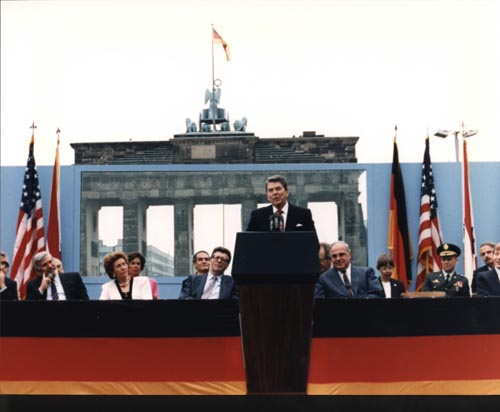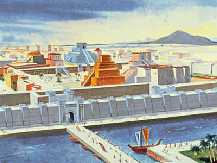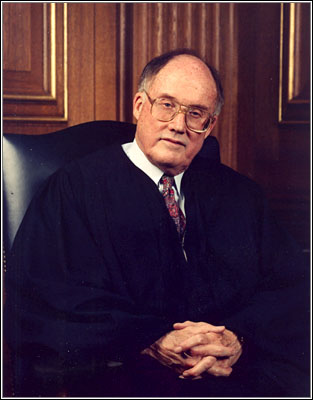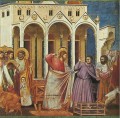Tear Down This Wall: Why It's Time to Dismantle the Wall of Separation Between Church and State

Walls are important. They were essential for protection in ancient times. There’s the colossal Great Wall of China and Hadrian’s Wall in northern England, both built with the intent of warding off the invading hordes. The width of the wall surrounding Nebuchadnezzar’s Babylon was about 25 feet, wide enough for two chariots to race side-by-side down the length of the wall. The biblical Nehemiah, a Jew of the Diaspora, upon hearing that the walls surrounding the city of Jerusalem were breached and that the gates of the city were burned, obtained permission for a leave of absence from Persia. With manpower and materiel, Nehemiah refortified the walls of Jerusalem in 52 days.
However, not all walls serve good purposes. In the twentieth century we witnessed a different kind of wall, a wall that served the goals of enslavement rather than security. Metaphorically, Winston Churchill referred to this barrier as the “Iron Curtain.” But Churchill’s Iron Curtain was no mere metaphor; the Iron Curtain represented a real political barrier whether we’re referring to the 17th Parallel that divided Vietnam, the 38th Parallel that separated Korea, or the Berlin Wall that divided a city. This 87-mile wall with its 116 guard towers and its “death strip,” entrapped its citizens and reminded us that slavery was alive and well on planet earth. Whether it was Vietnam, Korea, or Germany, these nations learned that a barrier can be constructed as an instrument of protection by their rulers, but can also be used as an instrument of oppression against its citizens.
Today, there is another wall that is billed as a protector, but really is an instrument of oppression. This wall is not made of brick and mortar, guard towers or barbed wire. Rather, it is a metaphorical wall, a construct of the mind, a barrier composed of erroneous history, misguided judges, and empty-headed repetition. Say anything against this barrier and instantly its attendants emerge, vouching for its veracity, swearing it to be a bedrock of our freedom. Every year millions of dollars are spent in fortifying this wall in government and society.
This barrier is the infamous Wall of Separation between church and state. The Wall of Separation metaphor is the main idea used by church and state separationists to keep religion, namely the Christian religion, out of the public square. Most likely out of fear that Christian fundamentalism will seize control of the government, groups like the ACLU and Americans United spend millions of dollars a year to assuage their paranoia that Pat Robertson is going to take over the government.
How did we go from a nation that acknowledged Christianity at every turn to a nation that is publicly so hostile to religious expression that we send little school girls to the principal for bringing a Bible to class? Like that frog in cold water being slowly boiled alive, this didn’t happen overnight. In effect, we have been on the path to limit religious freedom since the 1960s with the foundation laid in the 1940s.
The Wall of Separation
The metaphor “Wall of Separation” entered American history via Thomas Jefferson and into the jurisprudential lexicon via Reynolds v. US (1878). The threshold event that made the Wall of Separation the “law of the land” was the court case Everson v. Board of Education (1947) in which Justice Hugo Black, writing for the court majority, said that
The Constitution has erected a wall of separation between church and state; that wall must be kept high and impregnable.
Was Hugo Black right? Had the Constitution erected a “wall of separation between church and state,” a wall that “must be kept high and impregnable”? To get some better insight on this topic, it's necessary to look closer at the Constitutional standard for government’s relation to religion: the Establishment Clause.
The Standard: The Establishment Clause
Of the two expressions, "Wall of Separation" and "Establishment Clause," the latter is the only one that's important because it’s actually in the Constitution. The Establishment Clause is that phrase in the First Amendment to the Constitution that states
Congress shall make no law respecting an establishment of religion...
Read the phrase for yourself; you shouldn't need me or someone else to interpret it. But Wall of Separation proponents abruptly divert Americans from a common-sense reading of the Establishment Clause by offering the “Wall of Separation” spin on the Establishment Clause.
Separation proponents laden the Establishment Clause with second-rate ideas it was never intended to bear. They have done this by conflating the Establishment Clause with “Separation of Church and State” and “Wall of Separation.” If you go to the First Amendment and look for the concepts “church,” “state,” “wall,” or “separation,” good luck; you’ll actually have a better chance of finding Waldo. Future Americans are going to howl, wondering how we could have been so gullible as to swallow this whopper.
Separation proponents will no doubt say: “wait, what about Article VI’s ban on religious oaths? Certainly that supports the idea of the separation of church and state.” No, not really. Some states had established churches at the time of the Constitution’s ratification (Massachusetts did not disestablish its church until 1833). A national religious oath would have had the national government promoting a specific version of the Christian religion to the exclusion of the others. This seems the best way to harmonize Article VI and what was written in the First Amendment two years later.

A “Misplaced Metaphor”
As for the Wall of Separation, it has no historical connection to either the Article VI prohibition on religious tests or the First Amendment’s Establishment Clause. Furthermore, the Wall of Separation is predicated on a lie, an unvarnished reading of the Establishment Clause indicates that Congress’ “neutrality” is among rival established state churches, not between secular or sacred, or between church or state. The “Wall of Separation” approach to the Establishment Clause has no historical grounding and has no more moral authority than Justice Taney’s Dred Scott. In the words of former Chief Justice William Rehnquist in his dissent in Wallace v. Jaffree (1985), “The ‘wall of separation between church and State’ is a metaphor based on bad history, a metaphor which has proved useless as a guide to judging. It should be frankly and explicitly abandoned.”
In his book Thomas Jefferson and the Wall of Separation Between Church and State, historian Daniel Dreisbach discusses the historical problems with using the "Wall of Separation" metaphor as a basis for interpreting the Establishment Clause. Among the issues he raises, Dreisbach points up that using Jefferson's metaphor is problematic given that Jefferson was neither that the Constitutional Convention that drafted the Constitution, nor was he a part of the state conventions that created the First Amendment. Also, Dreisbach points out that Jefferson's letter to the Danbury Baptist was probably politically motivated and perhaps not best representative of Jefferson's philosophy of jurisprudence.
Much freedom has been snatched away under this “misplaced metaphor.” Consider the loses in religious freedom since the 1947 Everson case:
· Engel v. Vitale (1962)—banned school-lead prayer
· Abington Township School District v. Schempp (1963)—banned Bible reading
· Stone v. Graham (1980)—banned posting the 10 Commandments in school
· Lee v. Weisman (1992)—banned non-sectarian prayer from religious official praying at high school events
· McCreary County v. ACLU of Kentucky (2005)—banned government-sponsored displays of the 10 Commandments on government property
These are just some of the losses that Americans have suffered under the Wall of Separation.

Tear Down This Wall!
In 1987 Ronald Reagan stood to give a speech in front of the Brandenburg Gate in Germany. Behind him: the Berlin Wall. In that speech commemorating the 750th anniversary of the founding of the city of Berlin, Reagan made a statement that will never be forgotten by East Berliners held captive behind that wall or their taskmasters that held them there. It was a speech that gave hope to those that may have lost hope long ago. Reagan issued the challenge to Mikhail Gorbachev when he said
Come here to this gate! Mr. Gorbachev, open this gate! Mr. Gorbachev, tear down this wall.
Reagan’s prophetic call became a reality in 1989 when East and West Berliners demolished the wall, the wall between east and west, between slave and free.
Today, the Wall of Separation, like the late Berlin Wall, has become a Wall of Segregation. Furthermore, it serves to hide what is for many their real purpose in protecting the Wall which is to keep Christian fundamentalists out of government. If the ACLU was really principled about keeping religion out of government, they would see to it that every Halloween celebration was shut down and there would be no more “cultural awareness” events celebrating Islam at your child’s school. But, the ACLU is afraid of the Muslims and they tend to feel right at home with the ghouls that come out on All Saint’s Eve, so I don’t think you’ll be seeing any action from the ACLU on those fronts.
Besides, the ACLU knows that Christians are mostly peaceful and when you have a battery of lawyers, you need to batter someone, which is why they take great liberties in smacking the fundies around: they can get away with it. Regardless, the Wall of Separation is designed to squelch the freedom of many in order to feed the paranoia of a few. It lacks historical connection to the United States Constitution. It’s time to retire the Wall of Separation to that same wing of the history museum that contains those leeches they used to drain the life from George Washington, the Edsel, and the Eight-Track Tape Player.
Wall of Separation Debate
Groups Defending America's Religious Freedoms
- Defending Religious Freedom, Parental Right, Employee Civil Liberties - The Pacific Justice Institut
Pacific Justice Institute is a non-profit 501(c)(3) legal defense organization specializing in the defense of religious freedom, parental rights, and other civil liberties. Pacific Justice Institute works diligently, without charge, to provide their - The National Legal Foundation - Supporting the Biblical Foundations of American Law
The National Legal Foundation is a non-profit, public interest law firm, dealing with religious liberty issues. - Christian Law Association
The Christian Law Association is a "ministry of legal helps." Its purpose is to provide free legal assistance to Bible-believing churches and Christians who are experiencing legal difficulty in practicing their religious faith because of governmental - Alliance Defense Fund - Defending Our First Liberty
The Alliance Defense Fund is a legal alliance defending the right to hear and speak the Truth, through strategy, training, funding, and litigation. ADF is focused on three key issues: Religious Freedom, Sanctity of Human Life, and Traditional Family - American Center for Law and Justice
The American Center for Law and Justice (ACLJ) focuses on constitutional law and is based in Washington, D.C. The ACLJ is specifically dedicated to the ideal that religious freedom and freedom of speech are inalienable, God-given rights. The Center's
© 2009 William R Bowen Jr








